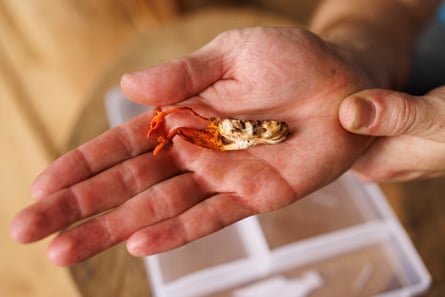DDeep in the harsh waters of Canada’s west coast, in a narrow channel surrounded by fjords, lies a coral reef that scientists say “should not exist.” The reef is the northernmost ever discovered in the Pacific Ocean and offers researchers new insight into the resilience – and unpredictability – of deep-sea ecosystems.
For generations, members of the The Kitasoo Xai’xais and Heiltsuk First Nations, two communities off British Columbia’s central coast region, had noticed large groups of rockfish congregating in a fjord system.
In 2021, researchers and First Nations, in collaboration with the Canadian government, deployed a remotely operated submersible to probe the depths of the Finlayson Channel, about 300 miles northwest of Vancouver.
During the last of around 20 dives, the team made a surprising discovery, which was only recently made public.
“When we started seeing the living corals, everyone had doubts,” explains Cherisse Du Preez, manager of the deep-sea ecology program at Fisheries and Oceans Canada. “Then when we saw the vast coral fields in front of us, everyone went wild. There were a lot of purely human emotions.
Despite the absolute darkness, the submersible’s lights captured the rich pinks, yellows and purples of the corals and sponges.
The following year, the team mapped Lophelia Reef, or q̓áuc̓íwísuxv, as it was named by the Kitasoo Xai’xais and Heiltsuk First Nations. It is the only known living coral reef in the country.
The discovery is the latest in a series of cases in which indigenous knowledge has pointed researchers toward areas of scientific or historical significance. More than a decade ago, Inuit oral historian Louie Kamookak compared Inuit stories with explorers’ logbooks and diaries to help locate Sir John Franklin’s lost ships, HMS Erebus and HMS Terror. In 2014, divers located the wreck of the Erebus in a location Kamookak suggested they look for, and with his instructions, they discovered the Terror two years later.
THE Lophelia corals that make up the reef are typical of those found on the bottom of the Atlantic and in parts of the Pacific south of California. Larger reefs can span several kilometers and take tens of thousands of years to mature. In the case of q̓áuc̓íwísuxv, the reef extends to 10 hectares (25 acres) of “thriving” coral.
“The Pacific has some of the oldest waters in the world, which means it contains low levels of oxygen, making it difficult for corals to survive,” says Du Preez.
The North Pacific also has high levels of acidity, which dissolves the calcium carbonate structures of corals. “For the longest time, we thought the components needed to maintain a reef didn’t exist here,” she adds.
The team suspects that the reef’s unique location, in a fjord with abnormally cold waters, helps explain its ability to thrive. The ridge where the coral is located is also in a water column mixing zone, where highly oxygenated water is pushed toward the coral.
“At first you think a reef like this must be one of a kind. But that is not possible. This is not how nature works. So now we’re going to find the others who need to be there,” says Du Preez.
Last week, Canada’s federal Department of Fisheries announced all commercial and recreational bottom fisheries, including pelagic trawling, we could no longer fish in the region surrounding the reef.
Despite efforts to protect the area, dead corals found along the reef’s periphery highlight how the lophelia coral is particularly vulnerable to warming waters and increased acidification, hallmarks of climate change.
“These reefs are cemented to rock and if you dissolve the base, it will literally slide and collapse into the depths,” says Du Preez. “But if we can control all the activities that are happening in the region, then we will give this reef the best chance of surviving climate change – and perhaps even colonizing new areas.”
In addition to the Lophelia coral, the researchers also discovered a large reef of glass sponges. It is unlikely that the two species have occurred elsewhere in the world.
“In the depths of the ocean, there are no rules,” says Du Preez. “So you can make these two species live together, argue or cooperate. Few things are more exciting for scientists than seeing things that seemed impossible happen before our eyes.


